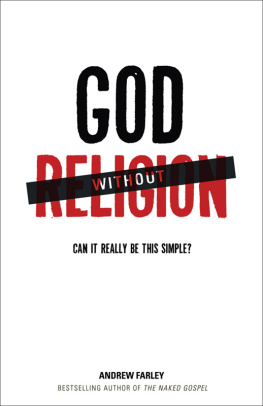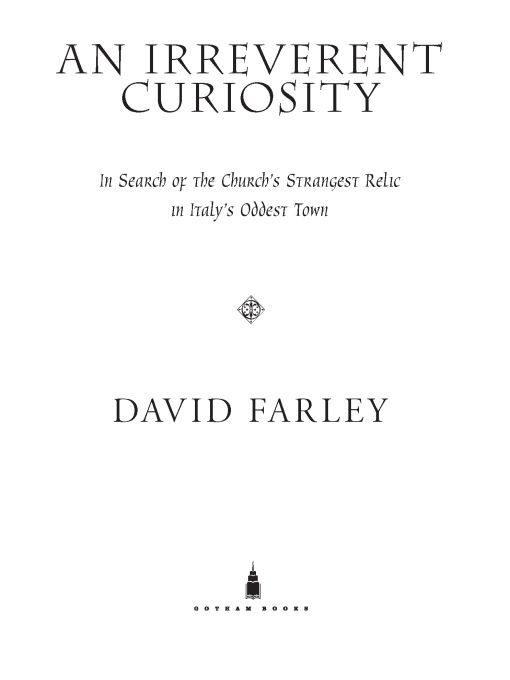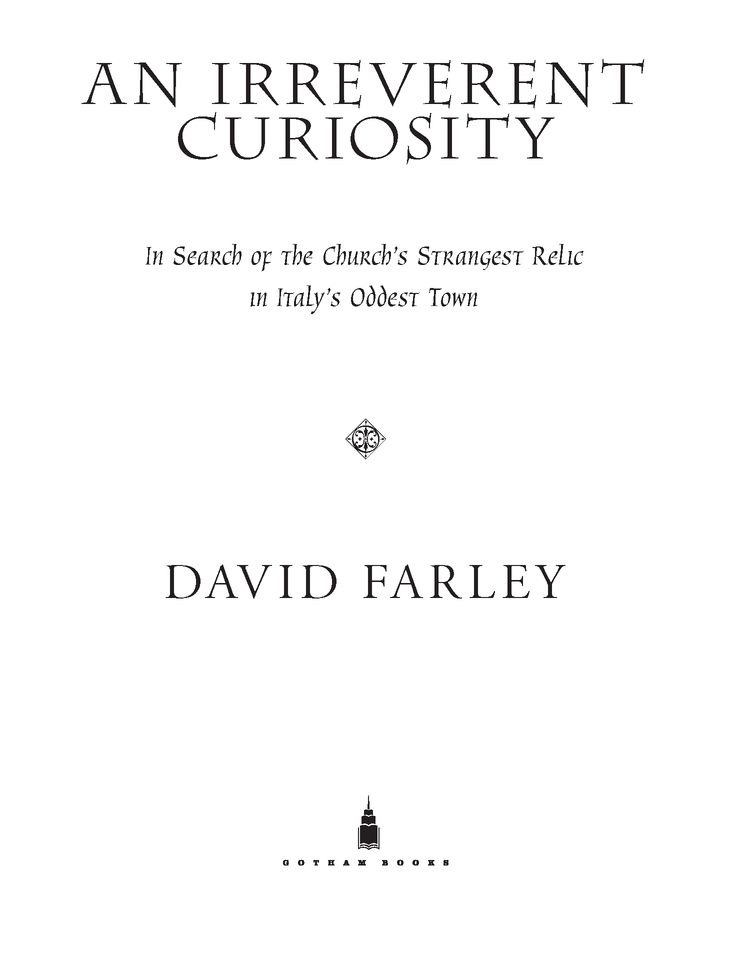Table of Contents
For The Magpie
Authors Note
Because I was not taking notes or recording every conversation that occurred during the researching of this book, some scenes were re-created from memory and some events have been condensed and/or rearranged.
Avoid those who do not blush to write books about the circumcision of the Lord.
ORIGEN, AS QUOTED BY GUIBERT OF NOGENT
Chapter 1
THE PREPUCE, THE PRIEST, AND THE WARDROBE
As Don Dario Magnoni draped the sacred vestments over his apple-shaped body, the pinch in his stomach blossomed into a knot. He had some bad news hed been keeping from his congregation. Hed decided late one recent night, after polishing off a bottle of cheap Montepulciano dAbruzzo, that this Sunday would be the day to tell themafter all, the New Years Day procession was just weeks away. The reason for the knot of nerves was that he didnt know how he was going to make the announcement to his small audience. Church attendance had been decreasing since he arrived in the village in the early 1970snow only a sprinkling of villagers regularly attended the Sunday massand Dario hoped the chilly December weather would keep more of the faithful from their weekly obligation. He straightened out his white chasuble and took a deep breath before sliding open the door that connected his house to the adobe-like church.
This year, Don Dario began the announcement, the holy relic will not be exposed to the devotion of the faithful. It has vanished. Sacrilegious thieves have taken it from my home. The priest paused, waiting for calamity to ensue. But the smattering of worshippers simply stared back at him in silence, a reaction Don Dario took as indifference.
The holy relic that Don Dario spoke of wasnt just the residuum of any holy humannor was it just any body part. It was the carne vera sacra, real holy flesh, as the people of Calcata admiringly referred to it. It was the foreskin of Jesus Christ, the only piece of the Redeemers body that he could have conceivably left on earth after his ascension into heaven, jealously guarded over in this secluded medieval hill town for the past four and a half centuries.
But now in 1983 the relic was gone. And most likely for good. After mass, some of the parishioners retreated to a nearby bar. Amid the posters and scarves of the Lazio football team, the churchgoers sipped espresso and prosecco and shook their heads in disbelief. Who would take our cherished relic? someone said without looking for an answer. But ancient Giuseppina shook her tiny fragile fist in the air and said, I know who took itthey took it.
The mystery of just what the Holy Foreskin was doing in the priests housein a shoe box at the back of his wardrobe, no lessand why and how it disappeared, kicked off the most cryptic case of relic theft in centuries. Who would steal it? And what would they want with it?
For the last century, the Churchs official position on the foreskin was one of silence, set out in a decree on February 3, 1900. Pope Leo XIII stated that anyone who talked about, wrote about, or commented on the Holy Foreskin would face excommunication. The Church feared the relic was being sought out simply as an irreverent curiosity. The people of Calcata could still hold their New Years Day procession with the relic, but that would be the only time each year it would be on displayand it would have to be from a distance and without commentary. The decree also stated that the word prepuzio, foreskin, should no longer be used when referring to the object inside the reliquary. Reliquia, relic, or cosa, thing, would be just fine from now on.
But long before this thing had its quiet falling-out with the Church, Christs foreskin was one of the most popular relics in Christendom. Saints pined for it: St. Catherine of Siena, the fourteenth-century Doctor of the Church and self-proclaimed spiritual bride of Christ, said she wore the foreskin around her ring finger; that same century, St. Bridget of Sweden claimed to have had a vision of the Virgin Mary, who told her that the Holy Foreskin (then kept in Rome) was the real deal. Several popes wrote about the pious prepuce and/or granted indulgences to those who celebrated it, including Leo III (birth unknown-816), Innocent III (1160-1216), Eugenius IV (1388-1447), Pius II (1405-1464), Sixtus IV (1414-1484), Sixtus V (1521-1590), Urban VIII (1568-1644), Innocent X (1574-1655), Alexander VII (1599-1667), and Benedict XIII (1649-1730). The thirteenth-century saint Bonaventure tried settling a theological dispute about the foreskins existence. And many of the players in the sixteenth-century Reformation (or those who inspired it)Jan Hus, Martin Luther, John Calvin, and Erasmus among themhave weighed in. While in Rome, nineteenth-century French writer Stendhal had hoped to visit Calcata to see it, and several other scribes have included it in their novels: James Joyce (Ulysses), Umberto Eco (Baudolino), Chuck Palahniuk (Choke), Jonathan Gash (The Grail Tree), and Jos Saramago (The Gospel According to Jesus Christ).
Christs flesh and blood are central to Catholic belief. Take, eat: this is my body, Christ said at the Last Supper, as recorded in 1 Corinthians 11:24. And thus the Eucharist, that tasteless wafer the priest gently places on the tongues of the faithful, was born as a substitute to the Saviors flesh. The Lateran Council in 1215, however, insistedthough not unanimouslythat during the Eucharist ceremony, the wafer actually became the flesh of Christ once it arrived in the middle of the devotees throat. That a piece of Christs actual fleshand his foreskin, no lesscould still be floating around posed a theological dilemma (and, undoubtedly, some discomfort) within the Church over the centuries. But also, the enduring enthusiasmamong the laity and, at times, within the Churchfor the Holy Foreskin is a reflection of the relic as the literal manifestation of the Eucharist.
It also made a lot of money. In the Middle Ages, a great relic meant pilgrims, which meant money, prestige, and power to those in control of a relicwhether it was an abbot, a prince, or even the pope. The foreskin of Christ was one of those cash-cow curios that packed in the pilgrims. So much so, it was eventually copied and forged all over Europe. Depending on what you read, there were eight, twelve, fourteen, or eighteen different Holy Foreskins in various European towns during the Middle Ages. Coulombs, a French village near Chartres, had one. Chartres also had one; as did the French towns of Metz, Charroux, Conques, Langres, Fcamp, and Puy-en-Velay. Auvergne had two. And the French werent the only ones with a holy foreskin obsession. Pieces of pious penises could be found in Hildesheim in Germany and Antwerp in Belgium. Santiago de Compostela, the famed pilgrimage town in the far northwestern corner of Spain, had one too. And, of course, there was the foreskin in Rome (the earliest and the one that ended up in Calcata).
















